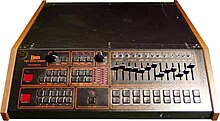Linn LM-1
| Linn LM-1 Drum Computer | |
|---|---|
 Linn LM-1 Drum Computer Rev. 3 | |
| Manufacturer | Linn Electronics |
| Dates | 1980–1983 |
| Price | US $4,995 - $5,500 - $3,995 |
| Technical specifications | |
| Polyphony | polyphonic: Rev. 1: 10 voices, Rev. 2 & 3: 9 voices |
| Timbrality | multitimbral 12 voices |
| Synthesis type | 8 bit Digital Samples / 28 kHz |
Storage memory | 100 memory patches |
| Effects | Individual level, pan, tuning for all sounds |
| Input/output | |
| Keyboard | 12 hard plastic "pads" |
| External control | pre-MIDI, external clock oscillator input, tape sync in/out |
The Linn LM-1 Drum Computer is a drum machine manufactured by Linn Electronics and released in 1980. It was the first drum machine to use samples of acoustic drums, and one of the first programmable drum machines. It became a staple of 1980s pop music, helping to establish drum machines as credible tools, and appears on records by artists including Human League, Gary Numan, Michael Jackson, and particularly Prince. The LM-1 was succeeded in 1982 by the LinnDrum.
Contents
1 Features
2 Development
3 Release
4 References
5 External links
Features
The LM-1, along with the Oberheim DMX, was one of the first drum machines to use samples (prerecorded sounds).[1] It features twelve 8-bit percussion samples, which can be individually tuned: kick, snare, hi-hat, cabasa, tambourine, two toms, two congas, cowbell, claves, and hand claps.[1] The machine also introduced features such as "timing correct" (quantization) and "shuffle" (swing) and the ability to chain patterns.[2]
Development
The LM-1 was designed by American engineer Roger Linn.[1] In 1978, Linn, a guitarist, was dissatisfied with drum machines available at the time, such as the Roland CR-78, and wanted "a drum machine that did more than play preset samba patterns and didn’t sound like crickets".[3] He took a voice generator from a Roland drum machine and wrote software to create patterns.[3]
At the suggestion of Toto keyboardist Steve Porcaro, Linn recorded samples of real drums to a computer chip.[1] Though Linn was not the first to use digital sampling technology, by the late 70s, it had become small and affordable enough to use in his drum machine.[3] As the samples were digital, they would not degrade like those of earlier devices, such as the Chamberlin Rhythmate, which used tape loops.[3]Cymbal sounds were not included, due to the cost of long sound samples.[2] Linn said he could not recall who played the drum hits recorded as samples; possibilities include Porcaro's brother Jeff (also of Toto) and Motown session drummer James Gadson.[1]
Linn introduced the shuffle feature after he discovered that his code would record his playing and play it back in perfect sixteenth notes, effectively correcting his timing. To implement swing beats, he delayed the playback of alternate sixteenth notes.[3]
Release
The LM-1 was announced in 1979 and released in 1980 as the first Linn Electronics product.[2] It retailed for $5,500.[1] Only 525 machines were built; Linn sold them by bringing prototypes to showbusiness parties.[1] Early adopters included Peter Gabriel, Fleetwood Mac, and Stevie Wonder. The machine became a staple of 1980s pop music, and appeared on hit records by artists including the Human League, Gary Numan, Michael Jackson, Giorgio Moroder, and particularly Prince.[1][3]
According to the Guardian, the LM-1, along with the DMX, helped establish drum machines as "credible, powerful instruments" rather than toys.[1] In 1982, it was succeeded by the cheaper and more stable LinnDrum, which was a commercial success.[1]
References
^ abcdefghij McNamee, David (2009-06-22). "Hey, what's that sound: Linn LM-1 Drum Computer and the Oberheim DMX". the Guardian. Retrieved 2018-02-09..mw-parser-output cite.citation{font-style:inherit}.mw-parser-output .citation q{quotes:"""""""'""'"}.mw-parser-output .citation .cs1-lock-free a{background:url("//upload.wikimedia.org/wikipedia/commons/thumb/6/65/Lock-green.svg/9px-Lock-green.svg.png")no-repeat;background-position:right .1em center}.mw-parser-output .citation .cs1-lock-limited a,.mw-parser-output .citation .cs1-lock-registration a{background:url("//upload.wikimedia.org/wikipedia/commons/thumb/d/d6/Lock-gray-alt-2.svg/9px-Lock-gray-alt-2.svg.png")no-repeat;background-position:right .1em center}.mw-parser-output .citation .cs1-lock-subscription a{background:url("//upload.wikimedia.org/wikipedia/commons/thumb/a/aa/Lock-red-alt-2.svg/9px-Lock-red-alt-2.svg.png")no-repeat;background-position:right .1em center}.mw-parser-output .cs1-subscription,.mw-parser-output .cs1-registration{color:#555}.mw-parser-output .cs1-subscription span,.mw-parser-output .cs1-registration span{border-bottom:1px dotted;cursor:help}.mw-parser-output .cs1-ws-icon a{background:url("//upload.wikimedia.org/wikipedia/commons/thumb/4/4c/Wikisource-logo.svg/12px-Wikisource-logo.svg.png")no-repeat;background-position:right .1em center}.mw-parser-output code.cs1-code{color:inherit;background:inherit;border:inherit;padding:inherit}.mw-parser-output .cs1-hidden-error{display:none;font-size:100%}.mw-parser-output .cs1-visible-error{font-size:100%}.mw-parser-output .cs1-maint{display:none;color:#33aa33;margin-left:0.3em}.mw-parser-output .cs1-subscription,.mw-parser-output .cs1-registration,.mw-parser-output .cs1-format{font-size:95%}.mw-parser-output .cs1-kern-left,.mw-parser-output .cs1-kern-wl-left{padding-left:0.2em}.mw-parser-output .cs1-kern-right,.mw-parser-output .cs1-kern-wl-right{padding-right:0.2em}
^ abc "Past Products Museum". www.rogerlinndesign.com. Retrieved 2018-02-09.
^ abcdef "The 14 drum machines that shaped modern music". FACT Magazine: Music News, New Music. 2016-09-22. Retrieved 2018-04-21.
External links
- Roger Linn Design
- | polynominal.com LINN LM1 page with manual and schematics